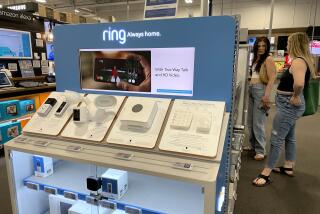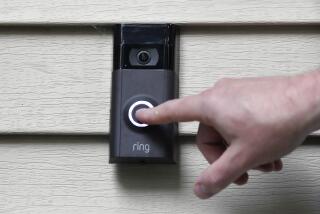User-Unfriendly
- Share via
I tried to back up the data on my Palm hand-held--decades of contact information--to a laptop. But instead of copying the data from the Palm to the laptop, my attempt to sync did precisely the opposite. It copied all the information on the laptop--i.e., nothing--onto the Palm. Put simply, all those precious phone numbers were erased.
I wasn’t panicked because I had another backup of the Palm data stored in other places, but I was puzzled. So I called up Palm tech support and explained the situation. The reply? “Oh, yeah, that happens sometimes. There’s nothing you can do. The data is gone.”
Welcome to the 21st century, where nothing works right, critical components of everyday life are far too complicated for average people to operate, and the guys responsible for foisting the whole mess upon the world don’t really seem to care. Computers, networks, VCRs, e-mail, even the lowly remote control have evolved from labor-saving devices into cranky, spiteful, hard-to-use, unreliable tools of the devil.
Does all this new technology really improve our productivity? I don’t see how it could since we’ve got to devote enormous amounts of time to understanding how to make this stuff work, preparing emergency plans to pull our keisters out of the wringer when it fails and implementing those disaster recovery programs.
But if you think our techno troubles are bad today, just wait. The world is becoming more interconnected. Just as computers are linked together through the Internet, so too will appliances such as televisions, stereos, air conditioners, even lights and telephones, all become one.
The marketing types like to talk about “convergence,” which means that soon there won’t be any meaningful difference between the computer, and the network, and the telephone, and radio and television. So what happens when we mix in the modern, unreliable technology--such as computers--with mature technology that generally works pretty well?
“We are at a crisis in software and computer related system development,” said Peter G. Neumann, principal scientist in the computer science laboratory at SRI International and an expert on building reliable systems.
“Stuff just doesn’t work,” Neumann said. “Today, our entire infrastructure is riddled with security and reliability holes. Given the fact that systems are far more interconnected than they’ve ever been before, this problem is going to get much worse. And everybody is asleep at the wheel.”
Not only is our new technology unreliable but it’s very hard for the vast majority of people to use. Take Microsoft’s Windows operating system. The company, whose operating systems run perhaps 95% of desktop computers, insists that it does extensive user testing on its products.
So why do I have to turn off my Windows PC by hitting the Start button? Would someone who had never turned off a computer before even think of hitting the Start key to quit?
When the technology does break, good luck trying to track down the source of the problem. Take e-mail, a truly transformative technology. In the event of an e-mail failure, however, the DSL provider will blame the Internet service provider; the ISP will blame the modem; the modem manufacturer will point a finger at the operating system, whose manufacturer will suggest a different e-mail program, whose developer will suggest the user is simply stupid.
It’s not just brand new technology that gives people fits. Even gizmos that have been around for two decades are still unreliable and frustrating to users. The vast majority of consumers use a VCR for only one thing: watching rental tapes. The whole “recorder” part of a VCR is pointless because users can’t figure out how to set the freaking clock, much less program the system to record the right channel at the right time.
“This is actually one of my pet peeves,” says usability guru Jakob Nielsen, who, as a principal with Nielsen Norman Group, is highly sought after by companies hoping to make their products easy for consumers to handle. “The VCR is so popular, but most people are never able to use it properly, unless you count the people who accidentally record the wrong program.”
Consumers tend to buy based on the features offered by a device, rather than on reliability or ease of use, because they don’t get the chance to test the devices before buying. In turn, manufacturers compete not by making more reliable products that are easier to use, but by adding features to products.
“More features means more complexity, and more complexity means there’s more of a chance that things will go wrong,” Nielsen says.
“It’s reached a point now where people don’t even complain to manufacturers when things don’t work any more. People blame themselves. They think, ‘If I can’t figure it out, it’s because I must be stupid.’ Or they think, ‘If I would only take the time to read the manual or attend a training course I could figure this out.’ What nobody realizes is that these things aren’t working for most people.”
A big part of the reason technology tends to fail is it’s gotten too complicated. Take remote controls. They used to be pretty straightforward devices, letting users adjust the volume and change channels. Now remotes duplicate every feature found on the object they operate. Result: massive confusion for most consumers.
“It’s gotten completely ridiculous,” Nielsen says. “Because of all these unique features, you can’t use one remote for all your components. People actually need special furniture now to organize all their remotes, but that doesn’t solve the problems of tiny buttons you can’t read that do things you don’t need.”
Manufacturers are aware of such complaints. One engineer for a major electronics company who agreed to a chat on condition of anonymity expressed frustration with consumers.
“From my perspective, the same people who manage to set the alarm on the digital clock next to their bed shouldn’t have a lot of problems setting the digital clock on the VCR.” He, as do others in the industry, insists that his company spends millions of dollars testing to make sure their products are easy to use. “We’re trying, we’re really trying, to address these problems. We just don’t know what else to do.”
Nielsen has a couple of suggestions. “Too many products are designed in ways that make sense to programmers but not to the regular person.”
All too often, he says, any serious usability problems aren’t identified until the product has been built.
“Usually what happens is they do a design and then come to us and say, ‘You need to make this easy.’ But the design has to be based on usability. Once you’ve already got the design, you’re doomed. That’s the basic problem with Windows right now: Any research they’ve done after the product is built can’t repair a fundamental flaw unless they’re prepared to throw everything out and start from scratch. All they can do now is put Band-Aids on it.”
In many ways, the Windows design is a staggering technical achievement--software that was written 10 years ago for Microsoft’s DOS operating system can often still run in the Windows environment. The personal computers Windows runs on are remarkably flexible, offering users an astounding variety of configurations to suit various circumstances.
But that very flexibility means the average user faces a bewildering array of choices. Making a machine that flexible requires enormous complexity, which increases the odds of failure at any moment.
What that means is users can have a perfectly functional computer system. But changing a single component can create an unstable system that regularly crashes if it manages to boot up at all.
As more and more devices are designed to work together, even appliances that are currently easy to use will become as failure-prone as the recent arrivals. Before I use the Internet to get the news, watch a movie, listen to music, order groceries and even cast a ballot, shouldn’t these questions of usability and reliability get worked out a little better?
If not, I fully expect to someday read stories about people who starve to death when their delivery guys never show up due to a computer crash. And the representatives of the companies responsible will respond with: “Oh, yeah, that happens sometimes.”
*
Dave Wilson is The Times’ personal technology columnist.






